Spatiotemporal Distribution Pattern and Driving Factors Analysis of GPP in Beijing-Tianjin-Hebei Region by Long-Term MODIS Data
Abstract
1. Introduction
2. Materials and Methods
2.1. Study Area
2.2. Data
2.2.1. GPP Datasets
2.2.2. Auxiliary Datasets
2.3. Methods
2.3.1. Pearson Correlation
2.3.2. Mann-Kendall Trend Test
2.3.3. Geodetector
3. Results
3.1. Spatiotemporal Distribution and Variation of GPP
3.2. Correlation Distribution of GPP with Precipitation, Temperature and Downward Surface Shortwave Radiation
3.3. Geodetector of GPP Spatial Distribution
3.3.1. Factor Detector
3.3.2. Ecological Detector
3.3.3. Interaction Detector of Five Factors
3.3.4. Risk Detector of Five Factors
4. Discussion
4.1. Spatiotemporal Distribution in the BTH
4.2. Correlation between GPP and LST, PR, SRAD
4.3. Dominant Driving Factors of GPP
4.4. Limitations of the Current Study
5. Conclusions
- (1)
- As far as spatial distribution is concerned, from northwest to southeast, the value of GPP gradually increases from a low value and then gradually decreases, which showed a low-high-low trend. The GPP of grassland and cultivated land in the Zhangjiakou region was in the range of 300 to 500 , while that of the Yanshan and Tai-hang Mountains was in the range of 600 to 850 , and that of cultivated land was in the range of 300–500 . The growth trend and spatial distribution showed a similar trend, and the Yanshan and Tai-hang Mountains showed a stronger growth trend, with a growth rate of 20–50 units. The growth trend was relatively slow in the northwest, while the growth area decreased in the central and southern plains, and no significant increase was observed in most regions. However, 68.73% of the area in the whole BTH showed an increasing trend.
- (2)
- In terms of time-series, GPP in the BTH presents a significant growth trend and has obvious seasonality, with a faster growth trend in summer and slower growth in spring and autumn. It also showed a relatively fast trend throughout the growing season.
- (3)
- The driving factors of GPP spatial differentiation in the whole BTH are land surface temperature, land use type, and nighttime light data, while precipitation and shortwave radiation contribute less. The increase of night light data indicates that human activities have an increasing influence on the spatial distribution of GPP.
- (4)
- The interaction among the five factors showed significant enhancement effects. In the future, proper attention should be paid to the effects of human factors and synergistic effects of multiple factors on the spatial differentiation of GPP, and the driving mechanism of spatial distribution of GPP should be further studied.
Author Contributions
Funding
Data Availability Statement
Conflicts of Interest
References
- Anav, A.; Friedlingstein, P.; Beer, C.; Ciais, P.; Harper, A.; Jones, C.; Murray-Tortarolo, G.; Papale, D.; Parazoo, N.C.; Peylin, P.; et al. Spatiotemporal patterns of terrestrial gross primary production: A review. Rev. Geophys. 2015, 53, 785–818. [Google Scholar] [CrossRef]
- Xiao, X.M.; Hollinger, D.; Aber, J.; Goltz, M.; Davidson, E.A.; Zhang, Q.Y.; Moore, B. Satellite-based modeling of gross primary production in an evergreen needleleaf forest. Remote Sens. Environ. 2004, 89, 519–534. [Google Scholar] [CrossRef]
- Wei, S.H.; Yi, C.X.; Fang, W.; Hendrey, G. A global study of GPP focusing on light-use efficiency in a random forest regression model. Ecosphere 2017, 8, e01724. [Google Scholar] [CrossRef]
- Field, C.B.; Randerson, J.T.; Malmstrom, C.M. Global Net Primary Production—Combining Ecology and Remote-Sensing. Remote Sens. Environ. 1995, 51, 74–88. [Google Scholar] [CrossRef]
- Prince, S.D.; Goward, S.N. Global primary production: A remote sensing approach. J. Biogeogr. 1995, 22, 815–835. [Google Scholar] [CrossRef]
- Yuan, W.P.; Liu, S.G.; Yu, G.R.; Bonnefond, J.M.; Chen, J.Q.; Davis, K.; Desai, A.R.; Goldstein, A.H.; Gianelle, D.; Rossi, F.; et al. Global estimates of evapotranspiration and gross primary production based on MODIS and global meteorology data. Remote Sens. Environ. 2010, 114, 1416–1431. [Google Scholar] [CrossRef]
- Running, S.W.; Nemani, R.R.; Heinsch, F.A.; Zhao, M.S.; Reeves, M.; Hashimoto, H. A continuous satellite-derived measure of global terrestrial primary production. Bioscience 2004, 54, 547–560. [Google Scholar] [CrossRef]
- Xiao, X.M.; Zhang, Q.Y.; Braswell, B.; Urbanski, S.; Boles, S.; Wofsy, S.; Berrien, M.; Ojima, D. Modeling gross primary production of temperate deciduous broadleaf forest using satellite images and climate data. Remote Sens. Environ. 2004, 91, 256–270. [Google Scholar] [CrossRef]
- King, D.A.; Turner, D.P.; Ritts, W.D. Parameterization of a diagnostic carbon cycle model for continental scale application. Remote Sens. Environ. 2011, 115, 1653–1664. [Google Scholar] [CrossRef]
- Hu, L.; Fan, W.; Ren, H.; Liu, S.; Cui, Y.; Zhao, P. Spatiotemporal Dynamics in Vegetation GPP over the Great Khingan Mountains Using GLASS Products from 1982 to 2015. Remote Sens. 2018, 10, 488. [Google Scholar] [CrossRef]
- Goulden, M.L.; Munger, J.W.; Fan, S.M.; Daube, B.C.; Wofsy, S.C. Exchange of carbon dioxide by a deciduous forest: Response to interannual climate variability. Science 1996, 271, 1576–1578. [Google Scholar] [CrossRef]
- Verma, M.; Friedl, M.A.; Law, B.E.; Bonal, D.; Kiely, G.; Black, T.A.; Wohlfahrt, G.; Moors, E.J.; Montagnani, L.; Marcolla, B.; et al. Improving the performance of remote sensing models for capturing intra- and inter-annual variations in daily GPP: An analysis using global FLUXNET tower data. Agric. For. Meteorol. 2015, 214, 416–429. [Google Scholar] [CrossRef]
- Guan, X.; Shen, H.; Li, X.; Gan, W.; Zhang, L. A long-term and comprehensive assessment of the urbanization-induced impacts on vegetation net primary productivity. Sci. Total Environ. 2019, 669, 342–352. [Google Scholar] [CrossRef] [PubMed]
- Cai, L.P.; Fan, D.L.; Wen, X.J.; Wang, H.; Badarifu; Wang, S.S. Spatiotemporal tendency of agricultural water use efficiency in the northernmost Yellow River: Indicator comparison and interactive driving factors. J. Arid Environ. 2022, 205, 104822. [Google Scholar] [CrossRef]
- Wang, K.; Cao, C.; Xie, B.; Xu, M.; Yang, X.; Guo, H.; Duerler, R.S. Analysis of the Spatial and Temporal Evolution Patterns of Grassland Health and Its Driving Factors in Xilingol. Remote Sens. 2022, 14, 5179. [Google Scholar] [CrossRef]
- Ma, J.; Xiao, X.; Miao, R.; Li, Y.; Chen, B.; Zhang, Y.; Zhao, B. Trends and controls of terrestrial gross primary productivity of China during 2000–2016. Environ. Res. Lett. 2019, 14, 084032. [Google Scholar] [CrossRef]
- Peng, C.C.; Li, B.; Nan, B. An analysis framework for the ecological security of urban agglomeration: A case study of the Beijing-Tianjin-Hebei urban agglomeration. J. Clean. Prod. 2021, 315, 128111. [Google Scholar] [CrossRef]
- Wang, Z.; Yang, L. Delinking indicators on regional industry development and carbon emissions: Beijing–Tianjin–Hebei economic band case. Ecol. Indic. 2015, 48, 41–48. [Google Scholar] [CrossRef]
- Bao, W.; Yang, Y.; Zou, L. How to reconcile land use conflicts in mega urban agglomeration? A scenario-based study in the Beijing-Tianjin-Hebei region, China. J. Environ. Manag. 2021, 296, 113168. [Google Scholar] [CrossRef]
- Yang, H.; Tao, W.; Liu, Y.; Qiu, M.; Liu, J.; Jiang, K.; Yi, K.; Xiao, Y.; Tao, S. The contribution of the Beijing, Tianjin and Hebei region’s iron and steel industry to local air pollution in winter. Environ. Pollut. 2019, 245, 1095–1106. [Google Scholar] [CrossRef]
- Pei, Y.Y.; Dong, J.W.; Zhang, Y.; Yang, J.L.; Zhang, Y.Q.; Jiang, C.Y.; Xiao, X.M. Performance of four state-of-the-art GPP products (VPM, MOD17, BESS and PML) for grasslands in drought years. Ecol. Inform. 2020, 56, 101052. [Google Scholar] [CrossRef]
- Linderholm, H.W. Growing season changes in the last century. Agric. For. Meteorol. 2006, 137, 1–14. [Google Scholar] [CrossRef]
- Wan, Z.M. New refinements and validation of the collection-6 MODIS land-surface temperature/emissivity product. Remote Sens. Environ. 2014, 140, 36–45. [Google Scholar] [CrossRef]
- Katsanos, D.; Retalis, A.; Michaelides, S. Validation of a high-resolution precipitation database (CHIRPS) over Cyprus for a 30-year period. Atmos. Res. 2016, 169, 459–464. [Google Scholar] [CrossRef]
- Abatzoglou, J.T.; Dobrowski, S.Z.; Parks, S.A.; Hegewisch, K.C. TerraClimate, a high-resolution global dataset of monthly climate and climatic water balance from 1958–2015. Sci. Data 2018, 5, 170191. [Google Scholar] [CrossRef]
- Chen, Z.; Yu, B.; Yang, C.; Zhou, Y.; Yao, S.; Qian, X.; Wang, C.; Wu, B.; Wu, J. An extended time series (2000–2018) of global NPP-VIIRS-like nighttime light data from a cross-sensor calibration. Earth Syst. Sci. Data 2021, 13, 889–906. [Google Scholar] [CrossRef]
- Gorelick, N.; Hancher, M.; Dixon, M.; Ilyushchenko, S.; Thau, D.; Moore, R. Google Earth Engine: Planetary-scale geospatial analysis for everyone. Remote Sens. Environ. 2017, 202, 18–27. [Google Scholar] [CrossRef]
- Benesty, J.; Chen, J.; Huang, Y.; Cohen, I. Pearson correlation coefficient. In Noise Reduction in Speech Processing; Springer: Berlin/Heidelberg, Germany, 2009; pp. 1–4. [Google Scholar]
- Wu, G.H.; Guan, K.Y.; Jiang, C.Y.; Peng, B.; Kimm, H.; Chen, M.; Yang, X.; Wang, S.; Suyker, A.E.; Bernacchi, C.J.; et al. Radiance-based NIRv as a proxy for GPP of corn and soybean. Environ. Res. Lett. 2020, 15, 034009. [Google Scholar] [CrossRef]
- McLeod, A.I. Kendall rank correlation and Mann-Kendall trend test. R Package Kendall 2005, 602, 1–10. [Google Scholar]
- Ay, M.; Kisi, O. Investigation of trend analysis of monthly total precipitation by an innovative method. Theor. Appl. Climatol. 2015, 120, 617–629. [Google Scholar] [CrossRef]
- Wang, J.F.; Li, X.H.; Christakos, G.; Liao, Y.L.; Zhang, T.; Gu, X.; Zheng, X.Y. Geographical Detectors-Based Health Risk Assessment and its Application in the Neural Tube Defects Study of the Heshun Region, China. Int. J. Geogr. Inf. Sci. 2010, 24, 107–127. [Google Scholar] [CrossRef]
- Menzel, A.; Fabian, P. Growing season extended in Europe. Nature 1999, 397, 659. [Google Scholar] [CrossRef]
- Li, Z.; Sun, X.; Huang, Z.; Zhang, X.; Wang, Z.; Li, S.; Zheng, W.; Zhai, B. Changes in nutrient balance, environmental effects, and green development after returning farmland to forests: A case study in Ningxia, China. Sci. Total Environ. 2020, 735, 139370. [Google Scholar] [CrossRef] [PubMed]
- Zhang, H.; Sun, R.; Peng, D.; Yang, X.; Wang, Y.; Hu, Y.; Zheng, S.; Zhang, J.; Bai, J.; Li, Q. Spatiotemporal dynamics of net primary productivity in China’s urban lands during 1982–2015. Remote Sens. 2021, 13, 400. [Google Scholar] [CrossRef]
- Fang, J.; Yu, G.; Liu, L.; Hu, S.; Chapin, F.S., 3rd. Climate change, human impacts, and carbon sequestration in China. Proc. Natl. Acad. Sci. USA 2018, 115, 4015–4020. [Google Scholar] [CrossRef]
- Hu, L.; Montzka, S.A.; Kaushik, A.; Andrews, A.E.; Sweeney, C.; Miller, J.; Baker, I.T.; Denning, S.; Campbell, E.; Shiga, Y.P.; et al. COS-derived GPP relationships with temperature and light help explain high-latitude atmospheric CO2 seasonal cycle amplification. Proc. Natl. Acad. Sci. USA 2021, 118, e2103423118. [Google Scholar] [CrossRef]
- Yan, S.; Wang, H.; Jiao, K.W. Spatiotemporal dynamic of NDVI in the Beijing–Tianjin–Hebei region based on MODIS data and quantitative attribution. J. Geo-Inf. Sci. 2019, 21, 767–780. [Google Scholar]
- Liu, X.J.; Liu, Z.Q.; Liu, L.Y.; Lu, X.L.; Chen, J.D.; Du, S.S.; Zou, C. Modelling the influence of incident radiation on the SIF-based GPP estimation for maize. Agric. For. Meteorol. 2021, 307, 108522. [Google Scholar] [CrossRef]
- Zhu, L.J.; Meng, J.J.; Zhu, L.K. Applying Geodetector to disentangle the contributions of natural and anthropogenic factors to NDVI variations in the middle reaches of the Heihe River Basin. Ecol. Indic. 2020, 117, 106545. [Google Scholar] [CrossRef]
- Li, H.; Liu, J.; Lei, X.; Ju, Y.; Bu, X.; Li, H. Quantitative Determination of Environmental Factors Governing the Snow Melting: A Geo-Detector Case Study in the Central Tienshan Mountains. Res. Square 2022. preprint. [Google Scholar] [CrossRef]
- Qiao, Y.; Wang, X.Q.; Han, Z.X.; Tian, M.; Wang, Q.; Wu, H.; Liu, F.T. Geodetector based identification of influencing factors on spatial distribution patterns of heavy metals in soil: A case in the upper reaches of the Yangtze River, China. Appl. Geochem. 2022, 146, 105459. [Google Scholar] [CrossRef]
- Zhao, Y.; Liu, L.; Kang, S.; Ao, Y.; Han, L.; Ma, C.J.L. Quantitative analysis of factors influencing spatial distribution of soil erosion based on geo-detector model under diverse geomorphological types. Land 2021, 10, 604. [Google Scholar] [CrossRef]
- Huo, H.; Sun, C.P. Spatiotemporal variation and influencing factors of vegetation dynamics based on Geodetector: A case study of the northwestern Yunnan Plateau, China. Ecol. Indic. 2021, 130, 108005. [Google Scholar] [CrossRef]
- Wan, H.W.; Li, H.X.; Wu, J.H.; Liu, Y.P. Spatial distribution pattern in mammal and bird richness and their relationship with ecosystem services in Sanjiangyuan National Park, China. J. Mount. Sci. 2021, 18, 1662–1677. [Google Scholar] [CrossRef]
- Xu, L.; Du, H.R.; Zhang, X.L. Driving forces of carbon dioxide emissions in China’s cities: An empirical analysis based on the geodetector method. J. Clean. Prod. 2021, 287, 125169. [Google Scholar] [CrossRef]
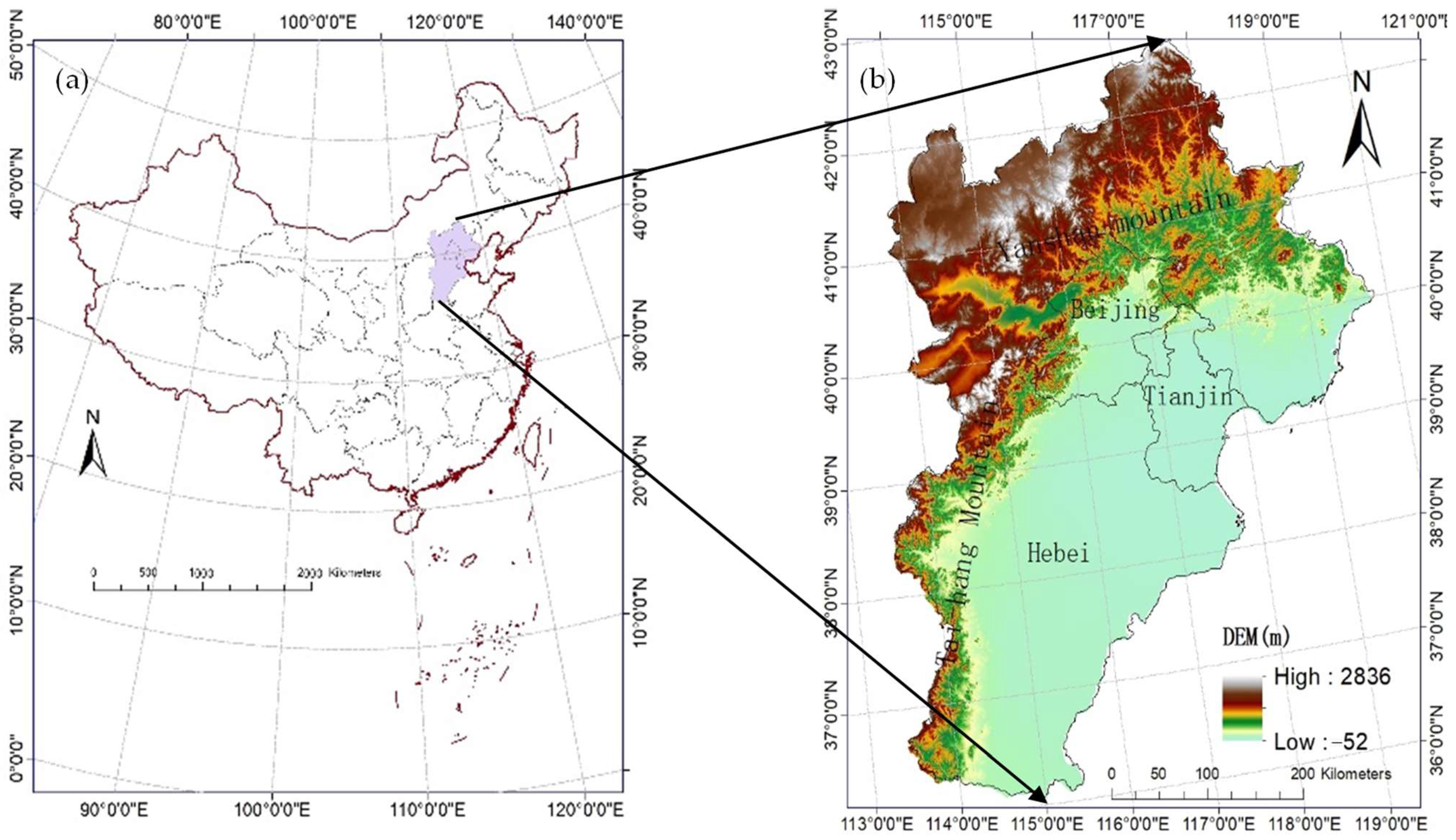

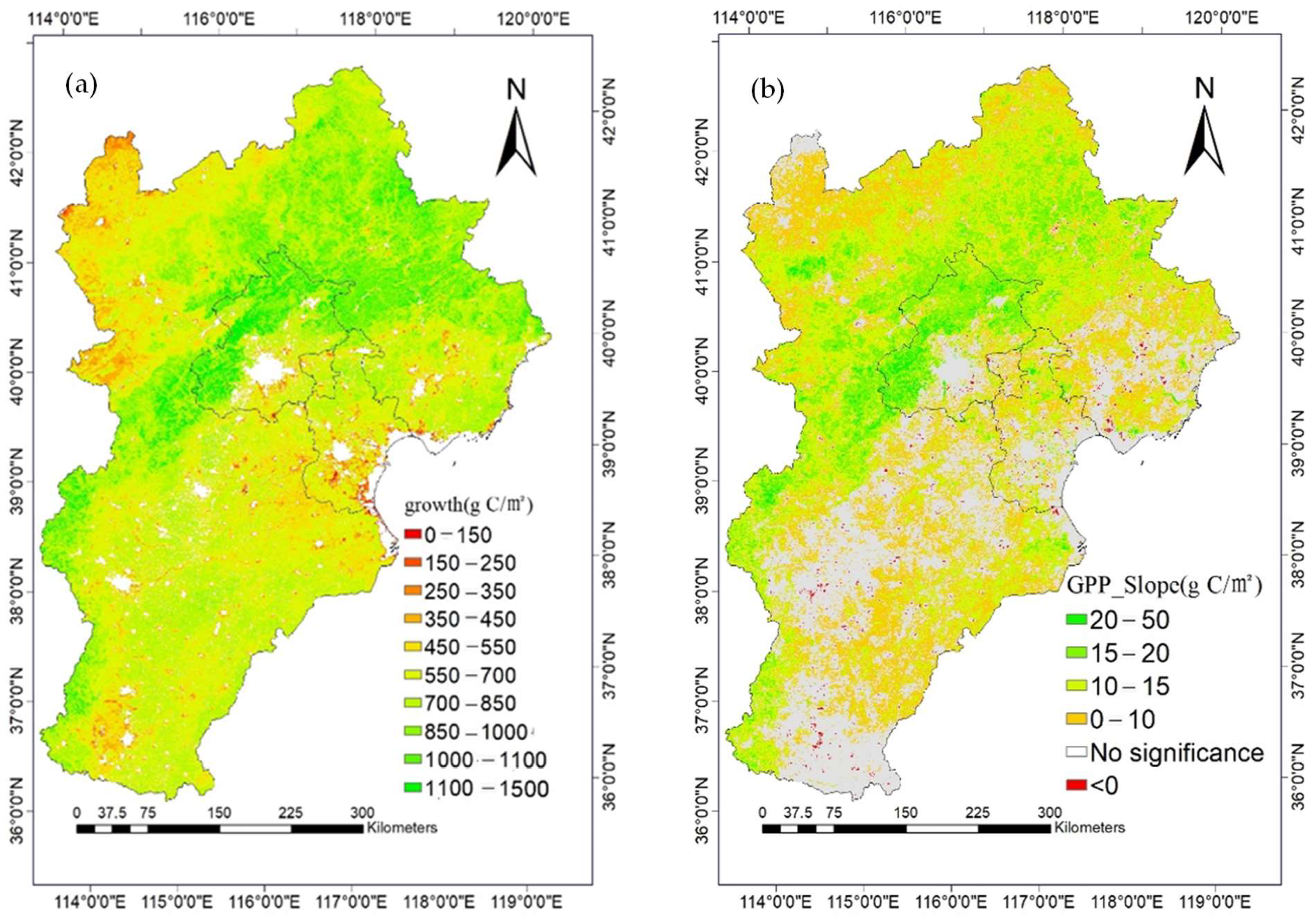


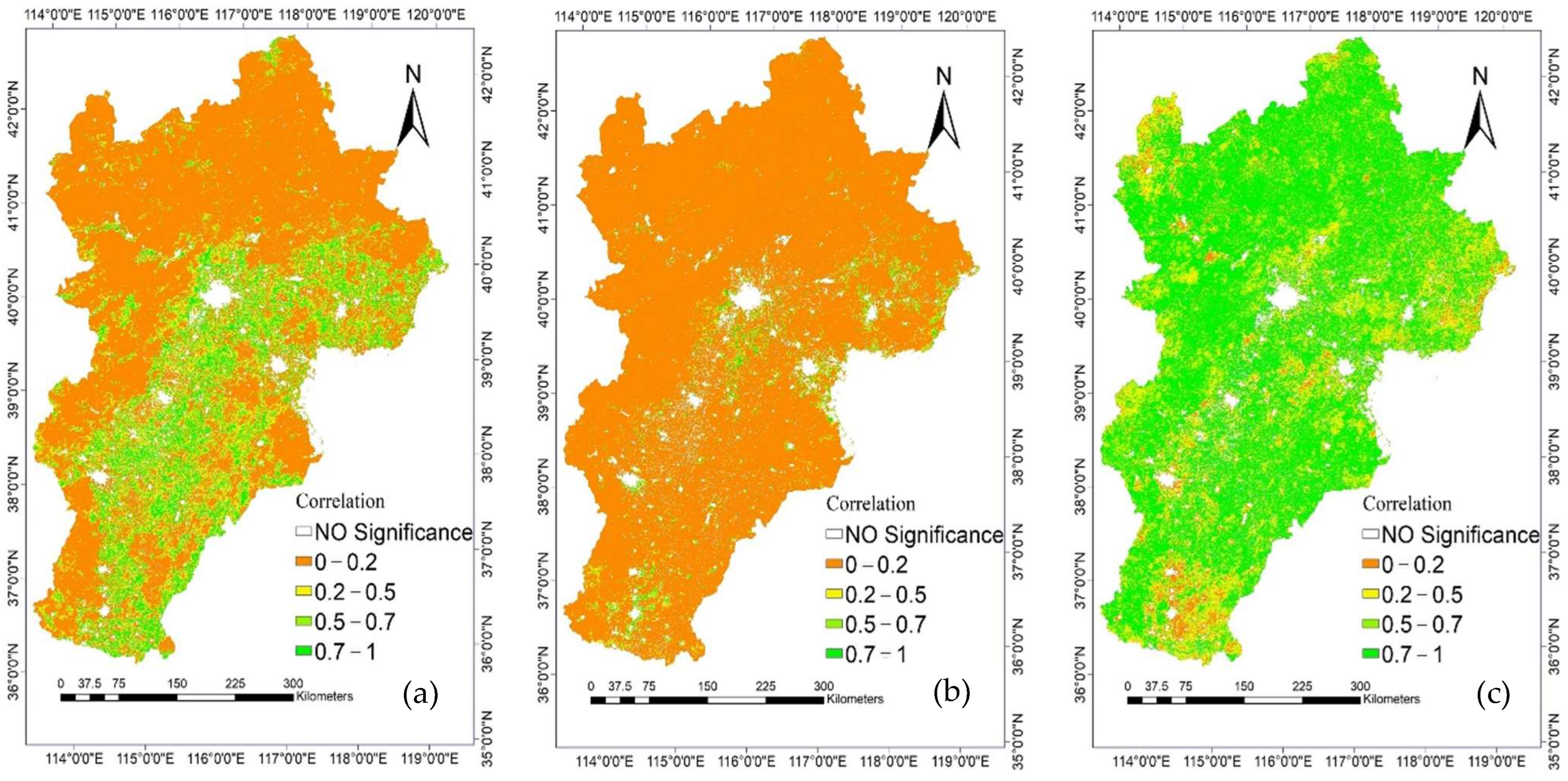
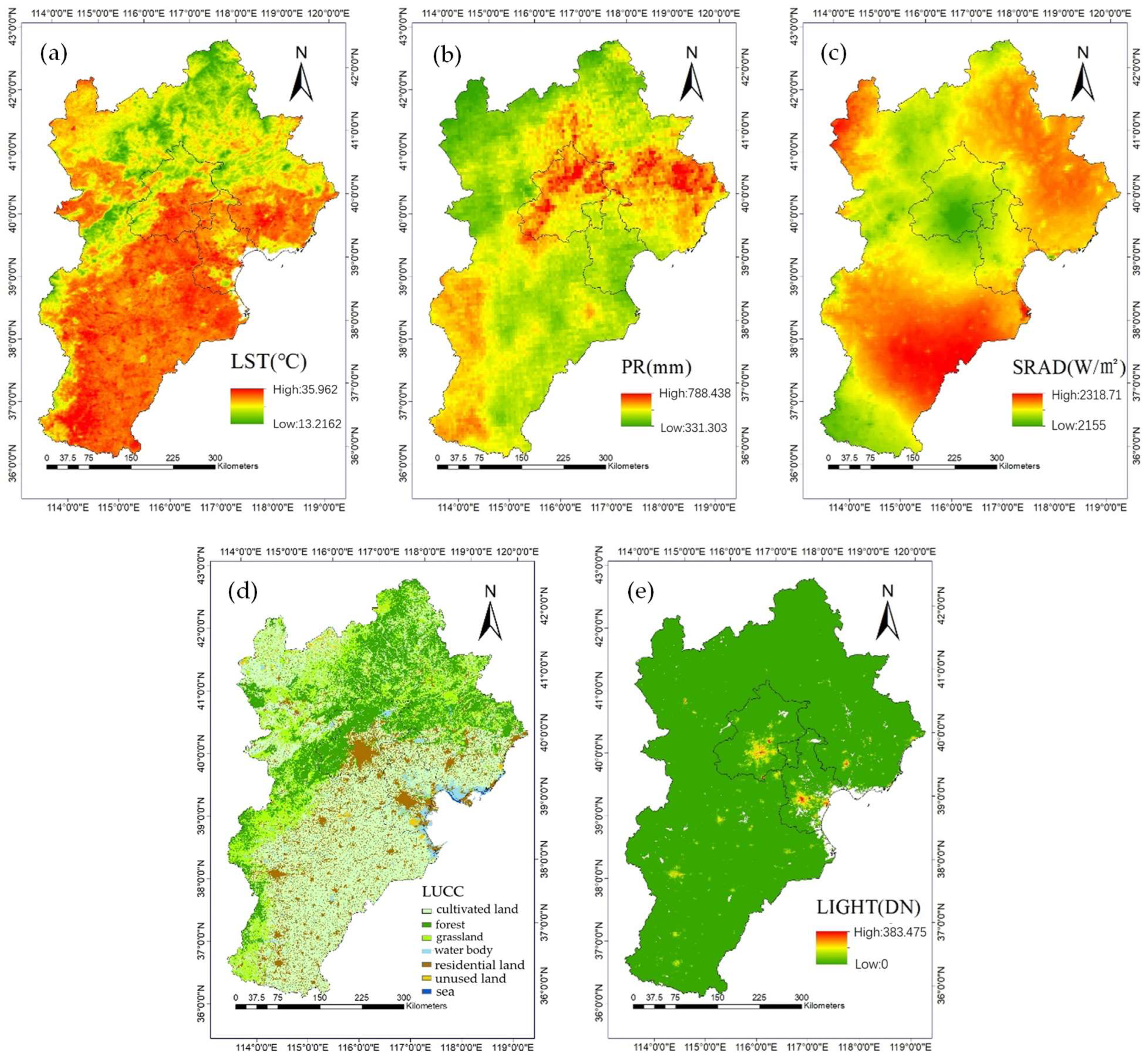
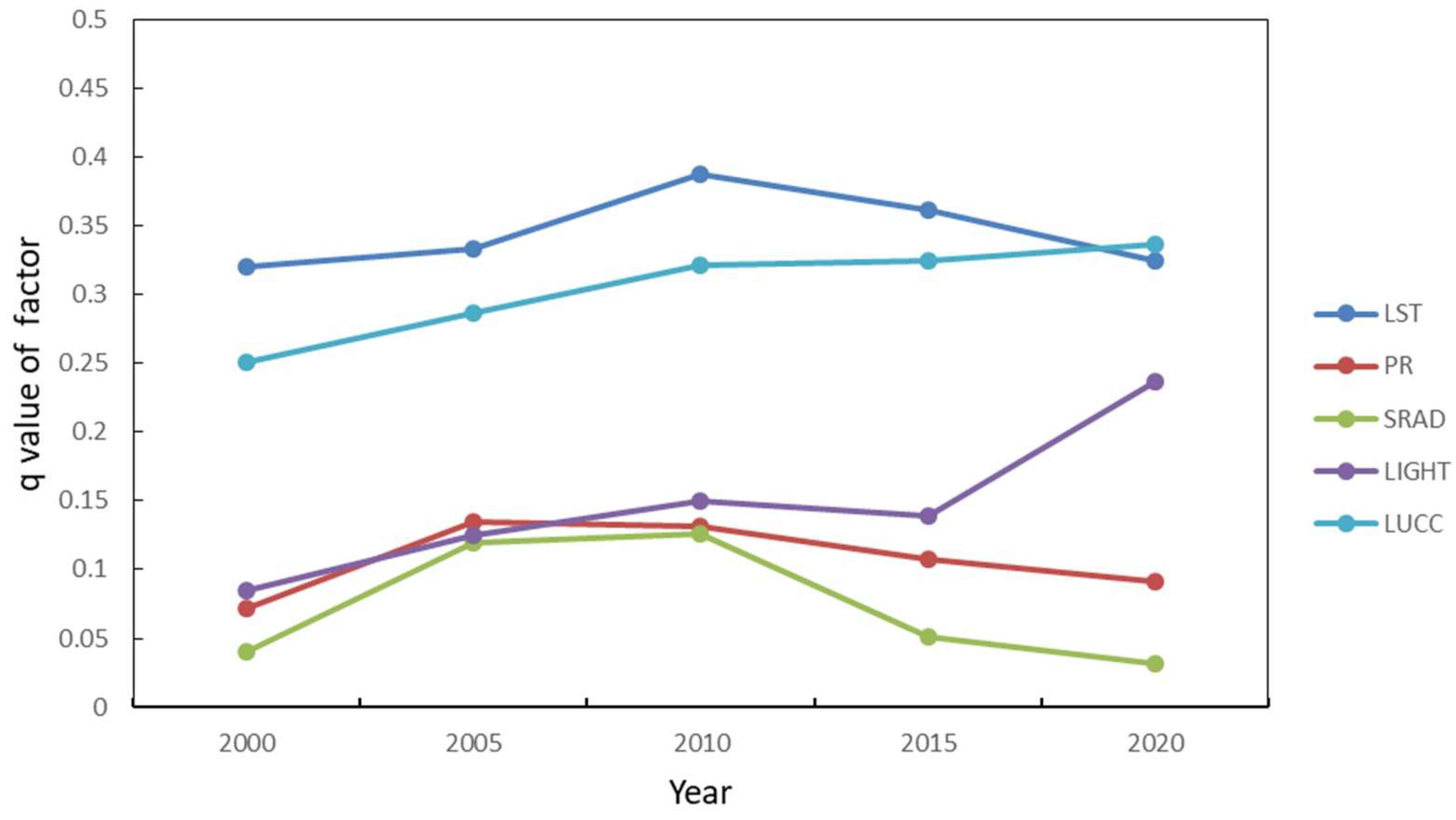
| q Value Comparison | Interaction |
|---|---|
| q() < Min(q(),q()) | Non-linear weakening |
| Min(q(),q()) < q() < Max (q(),q()) | Single-factor nonlinear attenuation |
| q() > Max(q(),q()) | Two-factor enhancement |
| q() = q() + q() | Independent |
| q() > q() + q() | Non-linear enhancement |
| LST | PR | SRAD | LIGHT | LUCC | |
|---|---|---|---|---|---|
| q statistic | 0.325 | 0.092 | 0.032 | 0.236 | 0.336 |
| p value | 0.000 | 0.000 | 0.000 | 0.000 | 0.000 |
| LST | PR | SRAD | LIGHT | LUCC | |
|---|---|---|---|---|---|
| LST | |||||
| PR | N | ||||
| SRAD | N | N | |||
| LIGHT | N | Y | Y | ||
| LUCC | N | Y | Y | Y |
| LST | PR | SRAD | LIGHT | LUCC | |
|---|---|---|---|---|---|
| LST | 0.325 | ||||
| PR | 0.430 | 0.092 | |||
| SRAD | 0.364 | 0.164 | 0.032 | ||
| LIGHT | 0.446 | 0.328 | 0.253 | 0.236 | |
| LUCC | 0.457 | 0.390 | 0.364 | 0.431 | 0.336 |
| Factor | Comfort Range or Type | |
|---|---|---|
| LST | 13.2–21.1 °C | 914.26 |
| PR | 645–788 mm | 910.13 |
| SRAD | 223.3–224.7 W/m2 | 702.55 |
| LIGHT | 0–4.5 | 714.99 |
| LUCC | forest | 887.33 |
Disclaimer/Publisher’s Note: The statements, opinions and data contained in all publications are solely those of the individual author(s) and contributor(s) and not of MDPI and/or the editor(s). MDPI and/or the editor(s) disclaim responsibility for any injury to people or property resulting from any ideas, methods, instructions or products referred to in the content. |
© 2023 by the authors. Licensee MDPI, Basel, Switzerland. This article is an open access article distributed under the terms and conditions of the Creative Commons Attribution (CC BY) license (https://creativecommons.org/licenses/by/4.0/).
Share and Cite
Guo, H.; Cao, C.; Xu, M.; Yang, X.; Chen, Y.; Wang, K.; Duerler, R.S.; Li, J.; Gao, X. Spatiotemporal Distribution Pattern and Driving Factors Analysis of GPP in Beijing-Tianjin-Hebei Region by Long-Term MODIS Data. Remote Sens. 2023, 15, 622. https://doi.org/10.3390/rs15030622
Guo H, Cao C, Xu M, Yang X, Chen Y, Wang K, Duerler RS, Li J, Gao X. Spatiotemporal Distribution Pattern and Driving Factors Analysis of GPP in Beijing-Tianjin-Hebei Region by Long-Term MODIS Data. Remote Sensing. 2023; 15(3):622. https://doi.org/10.3390/rs15030622
Chicago/Turabian StyleGuo, Heyi, Chunxiang Cao, Min Xu, Xinwei Yang, Yiyu Chen, Kaimin Wang, Robert Shea Duerler, Jingbo Li, and Xiaotong Gao. 2023. "Spatiotemporal Distribution Pattern and Driving Factors Analysis of GPP in Beijing-Tianjin-Hebei Region by Long-Term MODIS Data" Remote Sensing 15, no. 3: 622. https://doi.org/10.3390/rs15030622
APA StyleGuo, H., Cao, C., Xu, M., Yang, X., Chen, Y., Wang, K., Duerler, R. S., Li, J., & Gao, X. (2023). Spatiotemporal Distribution Pattern and Driving Factors Analysis of GPP in Beijing-Tianjin-Hebei Region by Long-Term MODIS Data. Remote Sensing, 15(3), 622. https://doi.org/10.3390/rs15030622






